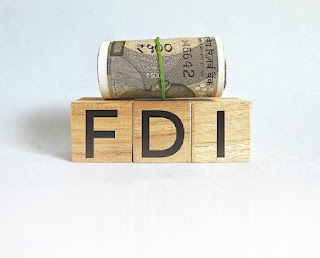Factors determining the level of FDI
FDI
Foreign Direct Investment, or FDI for short, is the process by which a firm or a person from one nation invests in assets or commercial ventures in another nation obtaining a 'lasting interest' and control of an enterprise.
Simply, as its full form suggest Foreign Direct Investment (FDI) it means a country or individual from the country directly putting investments in another country’s business or assets.FDI can encompass any material or intangible resources that enhance the investment in a foreign company; it is not just financial inputs. Establishing a long-term interest in the foreign entity is the goal of both kinds. (More)
Economic growth depends on foreign direct investment (FDI), which brings in money, technology, and experience. Multiple factors that foster an atmosphere that is favourable to foreign investors determine the amount of foreign direct investment (FDI) a nation draws.
1. Economic Stability
Investors want stable economies as they decrease the danger of currency volatility, inflation, and financial crises. Because returns are uncertain in an unstable economy, investment is discouraged. FDI is drawn to countries with stable fiscal policies and a strong GDP.
India’s economic stability post-1991 reforms led to a surge in FDI as liberalization policies stabilized the economy.
2. Tax and Financial Incentives
Investors are more drawn to nations with governments that provide favourable tax rates, exemptions, and financial incentives like grants or subsidies. Profitability is increased and operating expenses are decreased by these incentives.
Special Economic Zones (SEZs) in India offer duty exemptions and tax breaks to entice foreign direct investment (FDI) in the IT and industrial sectors.
3. Legal and Regulatory Framework
FDI is encouraged by clear and uniform laws pertaining to property rights, taxation, foreign ownership, and company operations. Investors are discouraged by complicated or uncertain regulations.
The United Kingdom’s strong legal framework protects foreign investors, attracting investments in real estate and financial services.
4. Infrastructure Development
Transportation, telecommunications, and energy supplies are examples of reliable infrastructure that lowers operating costs and guarantees efficient corporate operations. Inadequate infrastructure discourages investment and raises costs.
Modern ports, airports, and free zones are just a few examples of the UAE's sophisticated infrastructure, which has been a major draw for foreign direct investment.
5. Availability of Skilled Labor
An educated and highly competent workforce draws investment, particularly in labour-intensive or technology-driven businesses. When skill availability and competitive labour prices are combined, a nation becomes more attractive.
Ireland’s educated, English-speaking workforce has attracted tech giants like Google and Facebook to set up European headquarters.
6. Market Size and Growth Potential
Investors are drawn to nations with sizable populations or economies that are expanding quickly because of the possibility of increased sales and profits. An expanding middle class indicates higher spending power, which increases market profitability.
China’s vast market and growing consumer base have made it a magnet for FDI in sectors like retail, automobiles, and e-commerce.
7. Political Stability and Governance
Investors are reassured that their money is secure from abrupt policy shifts or instability when there is political stability. A fair business climate is ensured and corruption is decreased through transparent governance.
Singapore’s political stability and efficient administration have consistently ranked it as a top FDI destination.
8. Natural Resource Availability
FDI is drawn to nations with a wealth of natural resources, such as minerals, oil, or agricultural land, especially in sectors that require a lot of resources. Accessibility and effective resource management are essential.
Brazil’s rich natural resources, such as iron ore and coffee, have made it a significant FDI destination for mining and agricultural companies.
9. Trade Openness and Policies
Countries that are open to trade, with fewer restrictions on foreign ownership and import/export, attract FDI. Membership in trade agreements or blocs further boosts investor confidence.
Vietnam’s open trade policies and participation in multiple free trade agreements have attracted FDI, especially in manufacturing.
10. Proximity to Global Markets
Geographical position is important because nations close to important markets or trade routes save money and time on logistics, which attracts investors.
Mexico benefits from its proximity to the U.S., attracting FDI in automotive and manufacturing industries due to reduced transport costs.
A nation's FDI level is determined by a confluence of structural, political, and economic factors. Countries can increase their appeal to international investors by enacting investor-friendly legislation, preserving stability, and upgrading their infrastructure. In addition to strengthening the economy, FDI promotes employment, innovation, and global connectedness.






Comments
Post a Comment